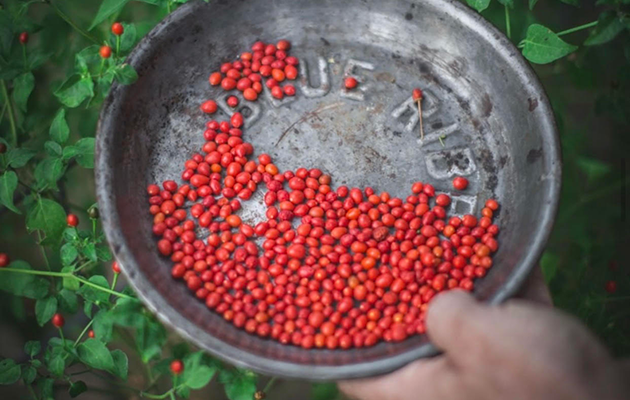Family heirlooms come in many shapes and sizes. My father’s sterling pillbox is a small circular vessel engraved with flowers and ferns. The scratches on the silver are signs of its long life spent traveling around in his front pocket. In lieu of pills, though, this sentimental heirloom, purchased on the Ponte Vecchio in Florence, safeguards a Texas treasure: the chile pequín, otherwise known as the chile piquin, chile tepin, the chile petín, and the chiltepin, which was named the state’s native pepper in 1997.

Perennial and drought resistant, these tiny red-hot peppers grow wild in Texas, Mexico, and the Southwest. Though nearly identical, they are variable to each region, and some believe the round tepin is hotter than the oblong pequín. “Overarching these problems is the belief of each person that they have the shape and name figured out,” says Melissa Guerra, a culinary expert and food historian living in South Texas. “The chilis and names morph and that’s just the way chilis are—they self-hybridize.” Despite their small differences, they are all scientifically known as Capsicum annuum, and are commonly called “bird peppers,” for the birds that consume them and spread their seeds. Unaffected by heat—or more specifically, the chemical compound capsaicin found within the pepper’s chamber—they feast on the fruit and deposit their droppings, producing new plants.
In San Antonio, bushes dense with the chilis appear down long alleyways, beneath old trees, and in backyards like mine. When I was growing up, my father routinely picked the peppers on our property. He’d let them dry in open air before stowing them in a pillbox, a bit of a cultural tradition in South Texas. (In fact, artisans such as the Texas silversmith Clint Orms create custom boxes for pequín lovers.) Whether my father was dining out, eating at home, or having lunch in his office, he’d pluck them one by one and sprinkle their seeds on his food. The dried chilis make a spicy, satisfying seasoning on everything from soups and pastas to tacos and meats. Crushed between two fingers, the pepper releases a fiery fairy dust that titillates taste buds.

My family’s enthusiasm for chile pequíns grew exponentially thanks to Alfa Campos. Campos, who grew up in Nuevo Laredo on the Texas–Mexico border, has been working with our family for more than thirty years. “This chili has been in my home for generations,” she says. Her mother, Maria, would harvest the peppers from their yard and make fresh salsas in her molcajete. It’s a tradition Campos continues today with her sensational chile pequín hot sauce, a well-loved, tight-lipped recipe refined over many years. The process is lengthy and laborious, with the hand-picked peppers soaking in white vinegar for a month before being blended, strained, and put away to age. There’s an alchemy to her handiwork, a patience and persistence not unlike making cheese or wine. “This is the presentation I like,” she says, holding up a glass dispenser filled with a golden, butternut squash–colored liquid.
Today, Campos’s chile pequín sauce continues to be popular among friends and extended family in our neighborhood. In my home, it’s never far away. But for those who don’t have access to the peppers or a great cook like Campos, the San Antonio native James Vives is spicing up the market with Brushfire Farms, his company making award-winning, small-batch glazes and spicy-sweet jams from chile pequíns. His “Hill Country Heat” preserves, featuring chile pequíns and homegrown Peruvian Ají Limón peppers, received a Good Food Award in 2019, a national accolade that recognizes sustainable artisanal manufacturers across the country. As his business continues to grow, so does his appreciation for the chili’s smoky, citrusy, nutty South Texas flavor. “It has a different bite than any other pepper,” he says. “I haven’t found anything like it.”








